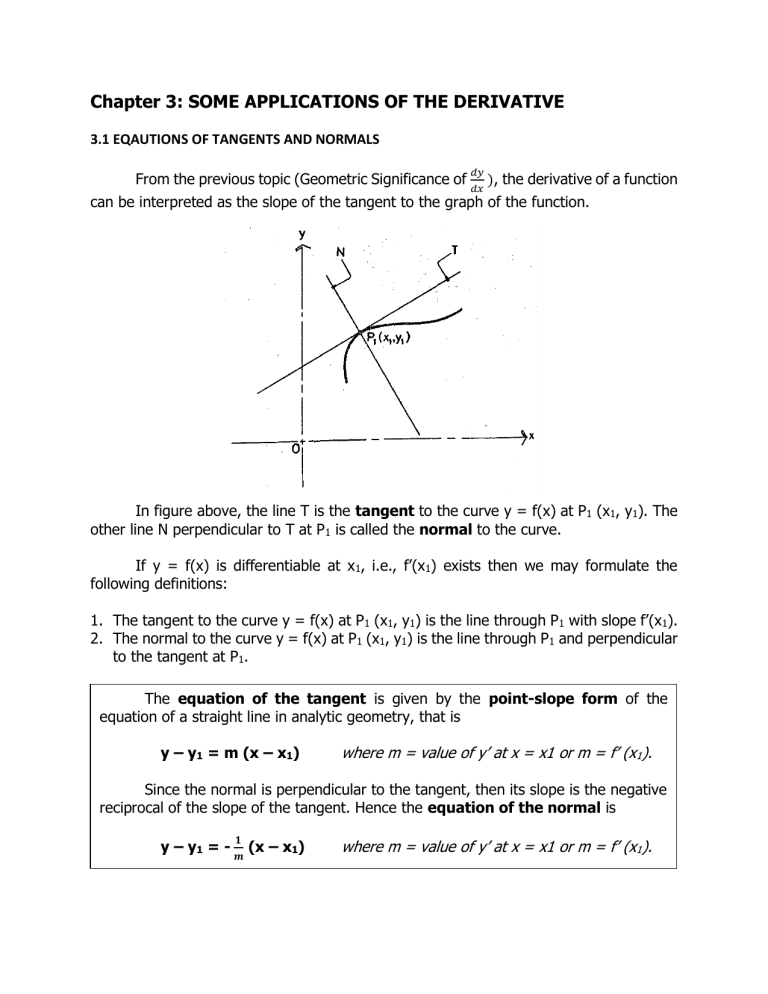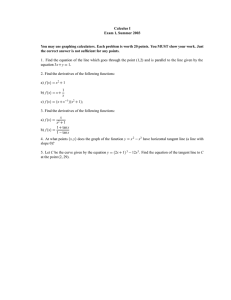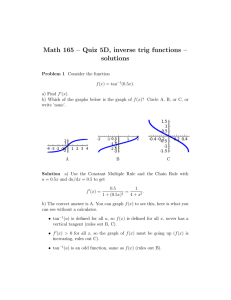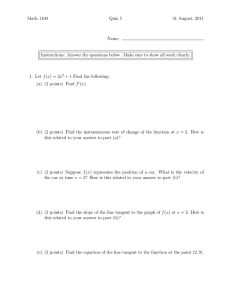Derivatives: Tangents, Normals, and Angle Between Curves
advertisement

Chapter 3: SOME APPLICATIONS OF THE DERIVATIVE 3.1 EQAUTIONS OF TANGENTS AND NORMALS 𝑑𝑦 From the previous topic (Geometric Significance of 𝑑𝑥 ), the derivative of a function can be interpreted as the slope of the tangent to the graph of the function. In figure above, the line T is the tangent to the curve y = f(x) at P1 (x1, y1). The other line N perpendicular to T at P1 is called the normal to the curve. If y = f(x) is differentiable at x1, i.e., f’(x1) exists then we may formulate the following definitions: 1. The tangent to the curve y = f(x) at P1 (x1, y1) is the line through P1 with slope f’(x1). 2. The normal to the curve y = f(x) at P1 (x1, y1) is the line through P1 and perpendicular to the tangent at P1. The equation of the tangent is given by the point-slope form of the equation of a straight line in analytic geometry, that is y – y1 = m (x – x1) where m = value of y’ at x = x1 or m = f’ (x1). Since the normal is perpendicular to the tangent, then its slope is the negative reciprocal of the slope of the tangent. Hence the equation of the normal is y – y1 = - 𝟏 𝒎 (x – x1) where m = value of y’ at x = x1 or m = f’ (x1). Example: Find the equations of the tangent and normal to the curve y = x3 at the point (2,8). Solution: 1. Find y’: y’ = x3 = 3x2 2. The point of tangency is (2,8), so x1 = 2 and y1 = 8. Since m = y’, then, y’ = m = 3x2 = 3(2)2 = 12. 3. By using the equation of the tangent: y – y1 = m (x – x1) y – 8 = 12 (x – 2) 12x – y – 16 = 0 4. By using the equation of the normal: 1 y – y1 = - 𝑚 (x – x1) y–8=- 1 12 (x – 2) x + 12y – 98 = 0 Exercise 3.1 1. Find the equations of the tangent and normal to the graph of the given function at the given point. a) y = 3x2 – 2x + 1, b) y = 1 + 3√𝑥, c) y = x√𝑥 − 1, d) y2 = 𝑥3 4−𝑥 2 e) y = , 𝑥 , (2,9) (4,7) (5,10) (2,2) (1,2) 2. Where will the tangent to y = √4𝑥 at (1,2) cross the x-axis? 3. At what point on the curve xy2 = 6 will the normal pass through the origin? 4. Find the area of the triangle formed by the coordinate axes and the tangent to xy = 5 at (1,5). 5. Find the area of the triangle bounded by the coordinate axes and the tangent to y=x2 at the point (2,4). 6. Find the area of the triangle formed by the x-axis, the tangent and normal to xy = 4 at (2,2). 7. Find the tangent to x2 + y2 = 5 and parallel to 2x – y = 4. 8. Show that the tangent with slope m to y2 = 4ax is the line y = mx+ a/m. 3.2 ANGLE BETWEEN TWO CURVES The angle between two curves at a point of intersection may be defined as the angle between their tangents at this point of intersection. If the tangents are not perpendicular to each other, then such tangents form a pair of acute angles and a pair of obtuse angles. The acute and obtuse angles are supplementary. Consider the curves y = f1(x) and y = f2(x) which intersect at a point P0 (x0,y0) as shown in the figure above. Let 𝜃 1 and 𝜃 2 be the inclinations of the tangents T1 and T2 at P0, respectively. Let ∅ be the angle between these tangents. Then, ∅ is also the angle between the curves. It can easily be shown that ∅, 𝜃 1 and 𝜃 2 are related by the equation ∅ = 𝜃2 - 𝜃1 (1) Then taking the tangent of both sides of (1), we get tan ∅ = tan ( 𝜃 2 - 𝜃 1 ) (2) or tan ∅ = tan 𝜃2 − tan 𝜃1 1+ tan 𝜃2 tan 𝜃1 Let m1 and m2 be the slopes of T1 and T2, respectively. Then m1 = tan 𝜃1 and m2 = tan 𝜃2 . Substituting these in equation (3) above, we obtain tan ∅ = 𝑚2 − 𝑚1 1+ 𝑚2 𝑚1 NOTE: The sign of tan ∅ in (4) is positive or negative depending upon the values of 𝑚1 and 𝑚2 or on the order in which 𝑚1 and 𝑚2 are used. If tan ∅ > 0, then ∅ is acute and if tan ∅ < 0, then ∅ is obtuse. Since tan ∅ > 0 if ∅ is acute, then we may use the absolute value symbol in the right member of (4). Thus our final formula would be 𝒎 − 𝒎𝟏 tan ∅ = |𝟏+𝟐𝒎 𝟐 𝒎𝟏 | where the values of m1 and m2 are given by the derivatives of the functions at P0 (x0,y0). That is, Example: Find the acute angle of intersection between the curves x2 = 8y and xy = 8. Solution: Exercise 3.2 Find the acute angle between given curves. 1. y2 = 2x and 4x2 + 4y2 + 5y = 0 2. x2 + y2 = 5 and y2 = 4x + 8 3. x2y + 4a2y = 8a3 and x2 = 4ay 4. 2y2 = 9x and 3x2 = - 4y 5. x2y + 4y = 8 and x2y = 4 6. xy = 18 and y2 = 12x



